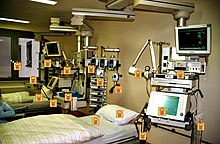
Back عدوى المستشفيات Arabic Infecció nosocomial Catalan Nemocniční nákaza Czech Hospitalsinfektion Danish Nosokomiale Infektion German Ενδονοσοκομειακή λοίμωξη Greek Infección nosocomial Spanish Hospitaalinfektsioon Estonian Infekzio nosokomial Basque عفونت بیمارستانی Persian
| Nosocomial infection | |
|---|---|
| Other names | HAI (Healthcare-Associated Infections) |
 | |
| Contaminated surfaces increase cross-transmission | |
| Specialty | Infectious disease |
A hospital-acquired infection, also known as a nosocomial infection (from the Greek nosokomeion, meaning "hospital"), is an infection that is acquired in a hospital or other healthcare facility.[1] To emphasize both hospital and nonhospital settings, it is sometimes instead called a healthcare-associated infection.[2] Such an infection can be acquired in a hospital, nursing home, rehabilitation facility, outpatient clinic, diagnostic laboratory or other clinical settings. A number of dynamic processes can bring contamination into operating rooms and other areas within nosocomial settings. [3][4] Infection is spread to the susceptible patient in the clinical setting by various means. Healthcare staff also spread infection, in addition to contaminated equipment, bed linens, or air droplets. The infection can originate from the outside environment, another infected patient, staff that may be infected, or in some cases, the source of the infection cannot be determined. In some cases the microorganism originates from the patient's own skin microbiota, becoming opportunistic after surgery or other procedures that compromise the protective skin barrier. Though the patient may have contracted the infection from their own skin, the infection is still considered nosocomial since it develops in the health care setting.[5] Nosocomial infection tends to lack evidence that it was present when the patient entered the healthcare setting, thus meaning it was acquired post-admission.[5][6]
- ^ Rosenthal VD, Bijie H, Maki DG, Mehta Y, Apisarnthanarak A, Medeiros EA, Leblebicioglu H, Fisher D, Álvarez-Moreno C, Khader IA, Martínez MD, Cuellar LE, Navoa-Ng JA, Abouqal R, Garcell HG (June 2012). "International Nosocomial Infection Control Consortium (INICC) report, data summary of 36 countries, for 2004-2009" (PDF). American Journal of Infection Control. 40 (5): 396–407. doi:10.1016/j.ajic.2011.05.020. PMID 21908073.
- ^ "HAI Data and Statistics". cdc.gov. 2018-01-10. Retrieved 2018-01-13.
- ^ Carroll GT, Kirschman DL, Mammana A (2022). "Increased CO2 levels in the operating room correlate with the number of healthcare workers present: An imperative for intentional crowd control". Patient Safety in Surgery. 16 (1): 35. doi:10.1186/s13037-022-00343-8. PMC 9672642. PMID 36397098. S2CID 253556197.
- ^ Carroll GT, Kirschman DL (2022). "Discrete room pressure drops predict door openings and contamination levels in the operating room setting". Perioperative Care and Operating Room Management. 29: 100291. doi:10.1016/j.pcorm.2022.100291. S2CID 252640995.
- ^ a b Monegro AF, Muppidi V, Regunath H (2020), "Hospital Acquired Infections", StatPearls, Treasure Island (FL): StatPearls Publishing, PMID 28722887, retrieved 2021-02-01
- ^ Sydnor ER, Perl TM (January 2011). "Hospital epidemiology and infection control in acute-care settings". Clinical Microbiology Reviews. 24 (1): 141–173. doi:10.1128/CMR.00027-10. ISSN 1098-6618. PMC 3021207. PMID 21233510.
© MMXXIII Rich X Search. We shall prevail. All rights reserved. Rich X Search